Many people use the term “viper” very casually to refer to just about any scary-looking snake, but scientifically, vipers belong to a very specific family of snakes within the massive Serpentes suborder of reptiles.
What kinds of traits do vipers share then, and what particular species are considered part of this group? How many unique types of vipers are there?
Let’s take a closer look at what exactly vipers are below and identify some of the most incredible viperid snakes all around the world!
What Is A Viper?
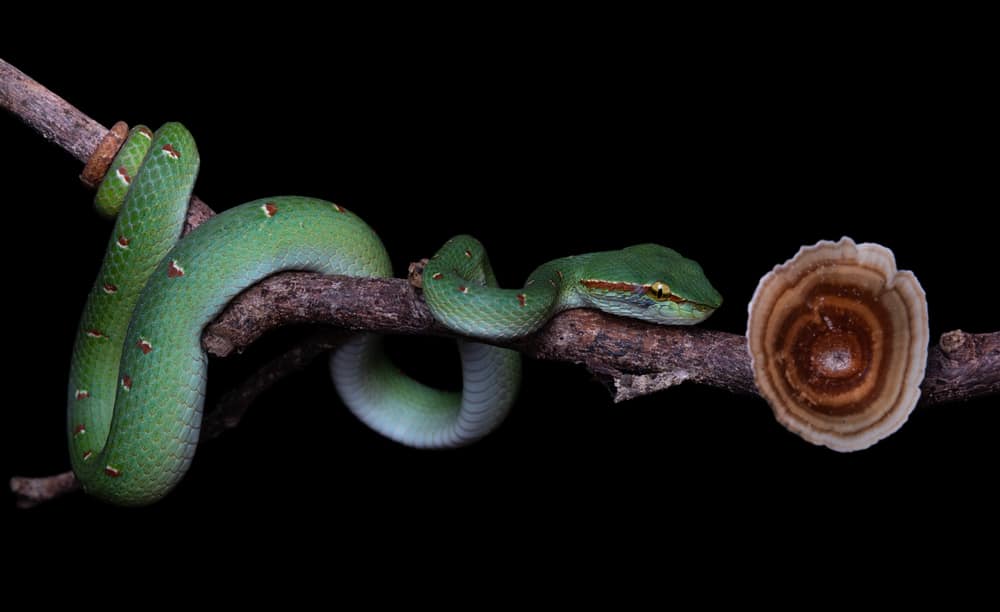
Vipers have long, hollow fangs and can deliver controlled quantities of venom. Most have keeled scales and give birth to live young that hatched from eggs internally.
©Nenad Preradovic/Shutterstock.com
There are more than 15 unique families of snakes within the Serpentes suborder of reptiles, including pythons, cobras, boas, and vipers, among many others! Essentially, a viper is any species of snake that is a member of the Viperidae family.
There are a few key traits that are common to viperid snakes. These include:
- Two long, hollow fangs for injecting venom are located at the back of the upper jaw below the eyes. The upper jaw muscles are extremely flexible to allow vipers to rotate their fangs independently. These fangs are folded against the roof of the mouth when not in use.
- The ability to deliver “dry bites” and carefully control how much venom is expelled per bite. This allows them to conserve venom and use only exactly how much is needed for situations like self-defense versus taking down small prey.
- Keeled scales, or ridged scales that splay slightly outward from the body, giving the snake’s skin a rough, textured appearance *(present in most but not all species)
- Ovoviviparity, or a means of reproduction where a snake’s young hatch from its eggs while still inside the snake’s body. The snake then gives live birth to their young and expels the remains of the eggs afterward. *(present in most but not all species)
Additionally, most vipers have short, wide bodies and broad, diamond-shaped heads. Finally, vipers are universally venomous, though they can possess several different types of venom, like hemotoxic and neurotoxic venom, which attack the blood and nerve tissue respectively.
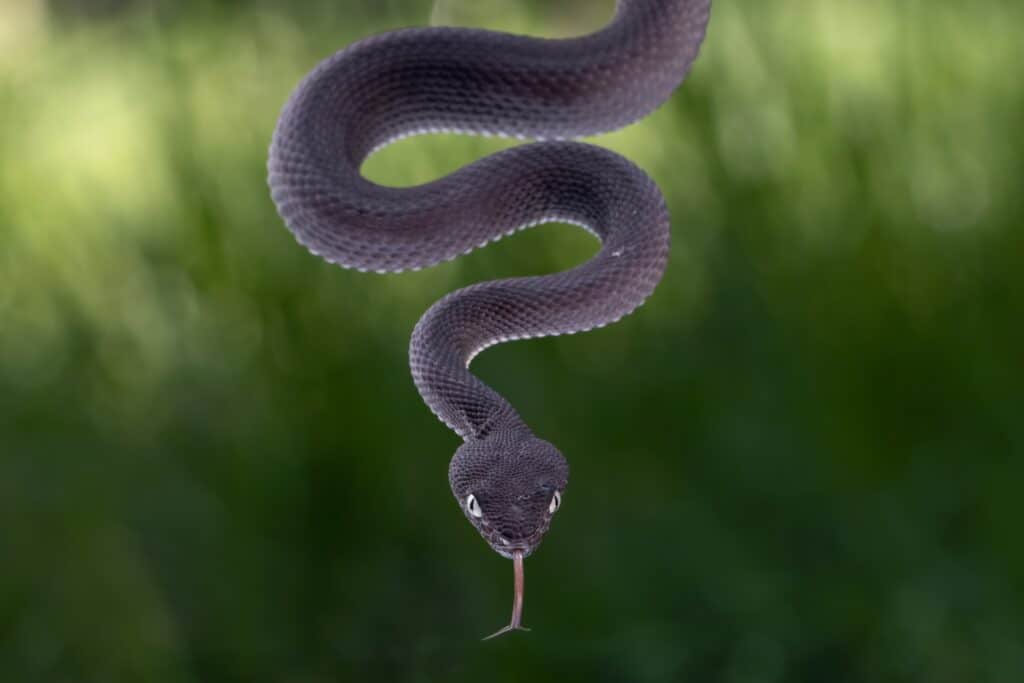
Mangrove Pit Viper
©Kurit afshen/Shutterstock.com
Within the Viperidae family are four distinct subfamilies of vipers:
- Crotalinae, known collectively as pit vipers
- Viperinae, known collectively as “true” or pitless vipers
- Azemiopinae, known collectively as Fea’s vipers
- Causinae, known collectively as night adders
Crotalinae, The Pit Vipers

Pit vipers like this March’s palm pit viper (
Bothriechis marchi) have heat-sensing pits located between their eyes and nostrils.
©Animantium Productions/Shutterstock.com
The most common type of viper within the Viperidae family is the pit viper. There are currently more than 150 species of pit vipers that live throughout the Americas and Eurasia. Interestingly, this subfamily of vipers is the only one with species residing in North America.
The term “pit viper” comes from the heat-sensing loreal pits located on either side of the snake’s head. These small pits are usually clearly visible between the nostrils and eyes. Pit vipers use these unique organs to sense changes in temperature, thermoregulate their bodies, and even locate their prey!
In addition to their special pit organs, pit vipers also possess a small muscle near their venom glands that contracts to help expel venom via their long, hollow fangs.
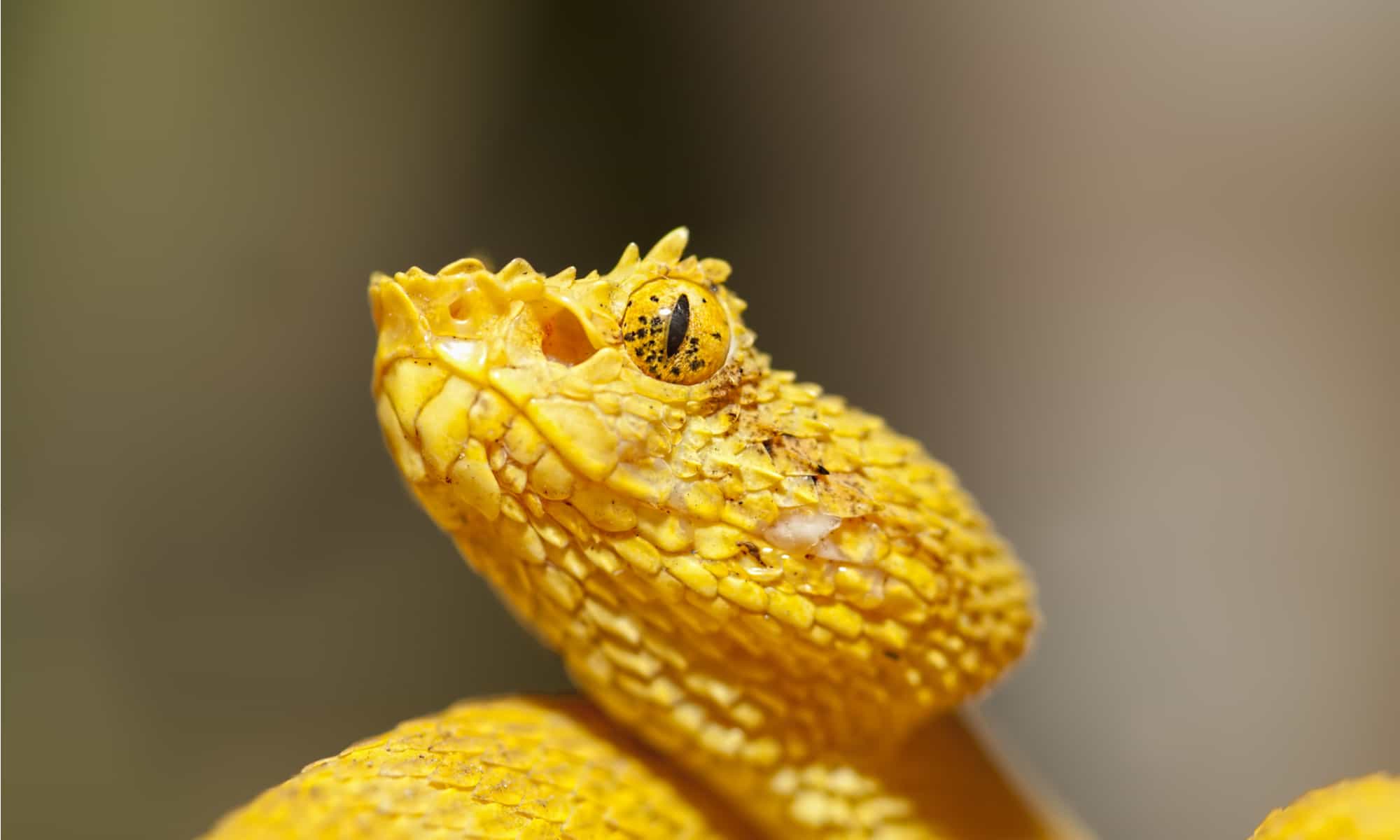
The Eyelash Viper has a distinct set of scales above their eyes that look like bold eyelashes.
©Roy H./Shutterstock.com
Some of the particular species that are part of this group include:
- Western diamondback rattlesnake (Crotalus atrox)
- Eyelash viper (Bothriechis schlegelii)
- Cottonmouth/Water moccasin (Agkistrodon piscivorus)
- Eastern copperhead (Agkistrodon contortrix)
- Side-striped palm-pit viper (Bothriechis lateralis)
Viperinae, The “True” Vipers
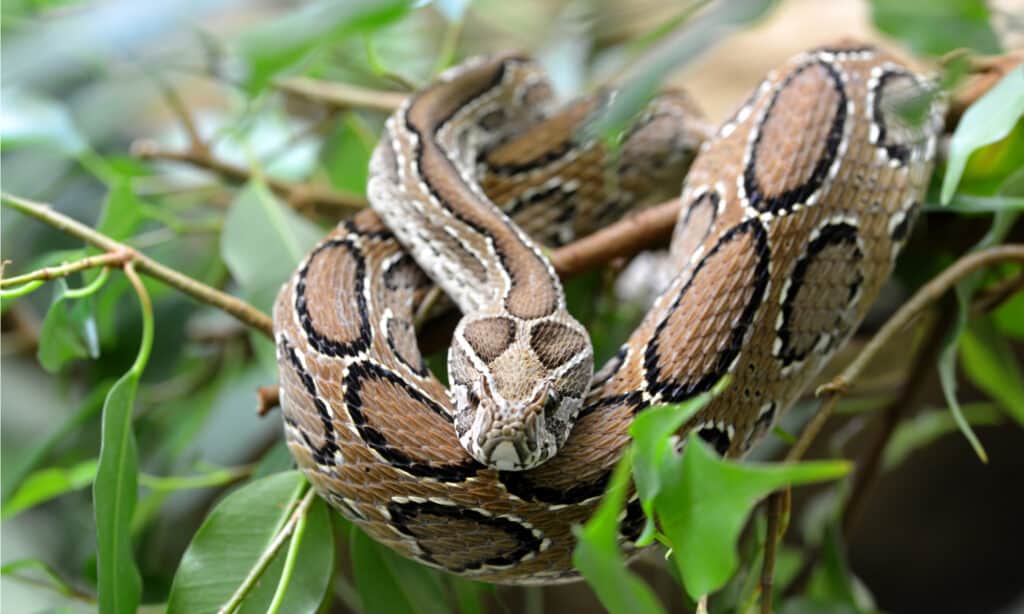
The Russell’s viper (
Dabouia russelii) is one of
India’s
deadliest “big four” snakes.
©jaroslava V/Shutterstock.com
The second-most abundant type of viper includes the “true” or “pitless” vipers within the Viperinae subfamily. This group contains a whopping 80 species spanning 13 different genera. Size varies significantly amongst the many Viperinae species, from as little as 12 inches to more than 6 feet in length, though most species have fairly bulky, short bodies.
Most of the members of the Viperinae subfamily are native to Eurasia and Africa. These snakes are also commonly known as “Old World vipers” due to the geographic regions they tend to inhabit.
Notably, these vipers lack the aforementioned pit vipers’ heat-sensing pit organs in their heads. However, they still possess a supranasal sac that helps them sense heat and locate prey, similar to how the pit organ functions. African vipers and puff adders of the Bitis genus in particular have especially sensitive and well-developed supranasal sacs.
Another trait most of these true vipers share is ovoviviparity. However, a handful of species, such as the horned vipers and most saw-scaled vipers, are oviparous and lay eggs instead.
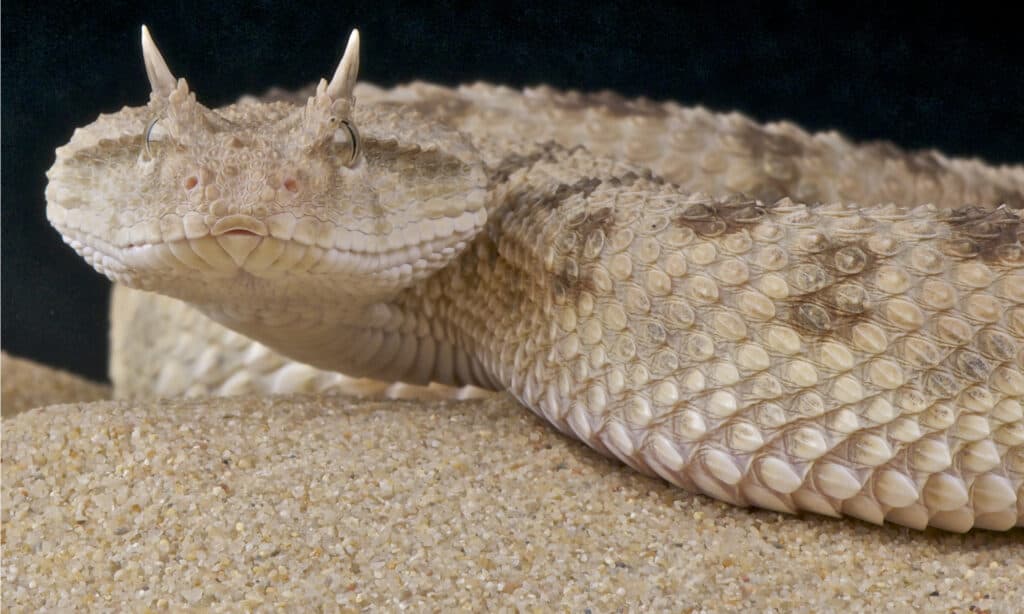
Horned desert viper / Cerastes cerastes
©reptiles4all/Shutterstock.com
Some of the particular species that are part of this group include:
- Rough-scaled bush viper (Atheris hispida)
- Gaboon viper (Bitis gabonica)
- Saw-scaled viper (Echis carinatus)
- Desert horned viper (Cerastes cerastes)
- Russell’s viper (Daboia russelii)
Azemiopinae, The Fea’s Vipers
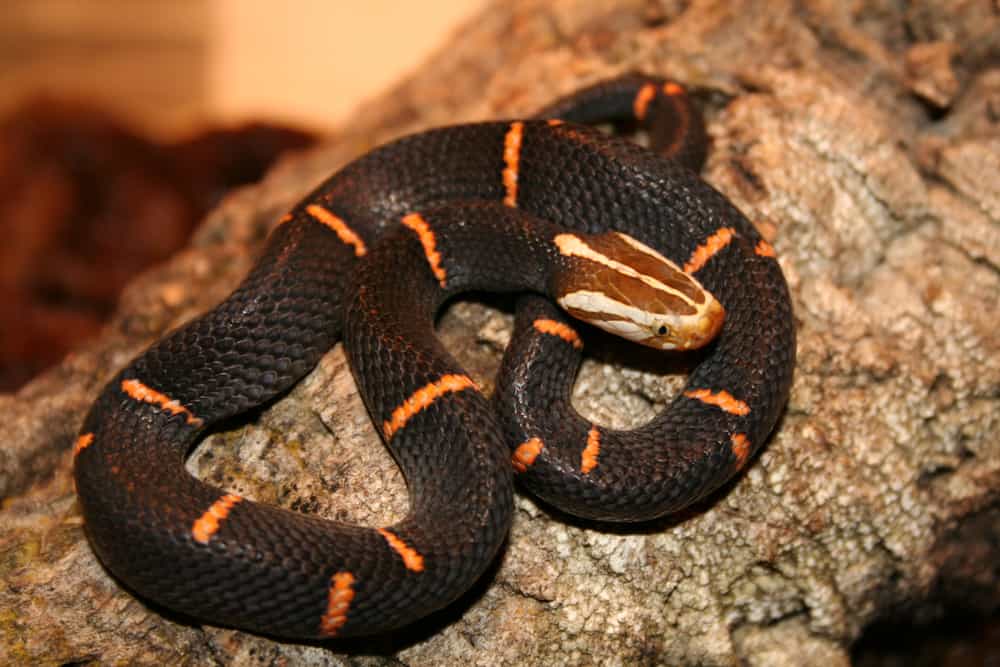
, one of two species of Fea’s vipers, resting on tree bark.
©IHX/Shutterstock.com
Azemiopinae is the smallest group of vipers within the four viper subfamilies. It contains only a single genus and just two known species: Azemiops feae and Azemiops kharini. They are collectively known as Fea’s vipers after the Italian explorer, Leonardo Fea, who originally discovered them in Southeast Asia.
Fea’s vipers are among the most primitive viper species in the world due to their rather unusual biology. They possess a number of traits that other viper subfamilies lack.
For starters, instead of the usual rough, keeled scales common to most vipers, Fea’s vipers have smooth scales covering their entire bodies. In addition, the scalation on and around their heads more closely resembles that of colubrid and elapid snakes than vipers. The individual scales on the head are also much larger than those of typical vipers.
Another rather unusual trait Fea’s vipers’ share is their short fangs compared to those of other viper species, which tend to be much longer. Fea’s vipers have shorter fangs and very small venom glands due to their fairly small, oval-shaped skulls compared to the more broad, diamond-shaped skulls of most typical vipers. They can, however, still rotate their fangs independently and use them to inject venom like other vipers.
Finally, also unlike most viper species, Fea’s vipers are oviparous, meaning they lay eggs rather than give live birth.
Causinae, The Night Adders

Night adders are among the most primitive types of vipers. Note this individual’s round pupils rather than the typical slit-shaped pupils of other viper species.
©NickEvansKZN/Shutterstock.com
Finally, we come to the second-smallest subfamily of vipers within the Viperidae family: Causinae. This group currently consists of a single genus and seven species, all of which are native only to sub-Saharan Africa and are known collectively as night adders.
Similar to the aforementioned Fea’s vipers, night adders are also among the most primitive types of vipers. This is due to several unique traits that the majority of viper species lack.
For starters, their pupils are round rather than slit-shaped like most other viper species. Their head shape also tends to be more long and more ovular than diamond-shaped, and it is covered in much larger scales. In addition, night adders have much shorter fangs than typical vipers, though they can still move and rotate independently.
Causinae species also have differently-shaped venom glands than those of most other viper species. Rather than being small and located near the back and sides of the head, the glands are long and slender and stretch down much of the snake’s neck. These venom glands can be up to four inches in length!
Finally, night adders’ internal biology is a bit unusual for a viper as well. In particular, their kidneys and lungs are uniquely long and slender. They are also oviparous, so they lay eggs rather than give live birth like most vipers.
The seven total species that belong to this group are as follows:
- Common night adder (Causus rhombeatus)
- Green night adder (Causus resimus)
- Angolan night adder (Causus rasmusseni)
- West African night adder (Causus maculatus)
- Lichtenstein’s night adder (Causus lichtensteinii)
- Snouted night adder (Causus defilippii)
- Two-striped night adder (Causus bilineatus)
Where Do Vipers Live?
Because there are so many different species of vipers, it’s safe to say that vipers are a large family of snakes. The Viperidae are found all over the world with the exception of remote places. A shorter list would be the places vipers can’t be found, such as Antarctica. However, vipers are also not found in Australia, New Zealand, Madagascar, and North of the Article Circle as well as island clusters like Hawaii.
Lifespan: How Long Do Vipers Live?
As with most species of snakes, little is known about the lifespan of a wild viper. However, in captivity, vipers can live to be about 20 years old. Additionally, females give live birth to about 50 to 60 babies at a time.
Summary of the Types of Vipers
| Types of Vipers | Common Species | |
|---|---|---|
| 1 | Crotalinae (Pit Vipers) | Western Diamondback Rattlesnake, Eyelash Viper, Cottonmouth, Eastern Copperhead, Side-Striped Palm-Pit Viper |
| 2 | Viperinae (True/Pitless Vipers) | Rough-Scaled Bush Viper, Gaboon Viper, Saw-Scaled Viper, Desert Horned Viper, Russell’s Viper |
| 3 | Azemiopinae (Fea’s Vipers) | Azemiops feae, Azemiops kharini |
| 4 | Causinae (Night Adders) | Common Night Adder, Green Night Adder, Angolan Night Adder, West African Night Adder, Lichtenstein’s Night Adder, Snouted Night Adder, Two-Striped Night Adder |
The photo featured at the top of this post is © Mark Kostich/Shutterstock.com
Discover the "Monster" Snake 5X Bigger than an Anaconda
Every day A-Z Animals sends out some of the most incredible facts in the world from our free newsletter. Want to discover the 10 most beautiful snakes in the world, a "snake island" where you're never more than 3 feet from danger, or a "monster" snake 5X larger than an anaconda? Then sign up right now and you'll start receiving our daily newsletter absolutely free.
Thank you for reading! Have some feedback for us? Contact the AZ Animals editorial team.






